|
|

|
The Northern New Mexico Report

On
the left, Larry C. (CO) photographs Dr.
Steve C. (CO) measuring
a faint track impression during the Northern New Mexico
Expedition in September 2004.
|
|
This is the BFRO Overview Report for the September 2004 Expedition
in Northern New Mexico.
The report is drawn from statements and photos taken by the participants.
It was assembled by Mike Si. (AL) and edited by Kathy Moskowitz
(CA) and Alton Higgins (OK) and Matt Moneymaker (CA).
The report is an *overview* of the incidents and finds reported by
the expedition participants. The overview is not designed to
disseminate evidence details or data. It is the story of what happened
on the expedition, according to the participants.

Mike Si. (Clergyman AL) and Aaron Si. (IT Analyst, AL) peek
over a finger canyon rim into a pristine box
canyon where sasquatch tracks and scats were found.
|
|
One goal of the expedition was to identify the best areas for long-term
studies. Progressing to that point required a lot of preliminary work,
including face-to-face meetings with local witnesses, ground searches
where incidents have occurred in the past, and gathering local knowledge
about the plants, animals, people, seasons, road conditions and access,
and so forth.
As the ground searches yielded more and more evidence the searches
became more focused. By the final day there was no doubt among the
expedition participants on two important determinations: There was
little or no activity or evidence easily observable in most
locations; but there were a few, fairly pristine locations where
tracks, scats, sounds, etc., were much more abundant.

On the left, Mike Se. (cartographer from Albuquerque) listens
to John Ca. (airline pilot from Seattle) describing sounds
heard moments before in lower "Canyon C."
|
This public version of the expedition overview describes
characteristics of the locations, but not the place names
of the specific sites. In that sense a public report is "abridged,"
by necessity.
The specific sites were all on protected, private land. We have
been asked by the authorities who patrol the area to not mention
any place-names on the Internet.
The area selected for this expedition has a history of activity
(sightings, howls and track finds) in late summer and early fall.
The sighting information from this area is not posted on the publicly
accessible part of the BFRO sightings database, at the request of
the local residents who have been providing that information.
|
|
The site selected for the base camp was the ranch where some of
the incidents had occurred. The ranch owner was the host for the
expedition group.
|

Base
camp: A mountain ranch in Northerm New Mexico.
Elevation ~ 7,500 feet
|
|
Detective Work: Scouting the Area & Talking to the Local Witnesses
On Wednesday, September 1, the host took a BFRO advance team around
the area to show the topography, roads and other points of interest.
On Thursday, September 2, most of the expedition participants arrived.
The host arranged for several witnesses from the area to come to
the base camp and share their stories. The host's family and friends
generously provided food.
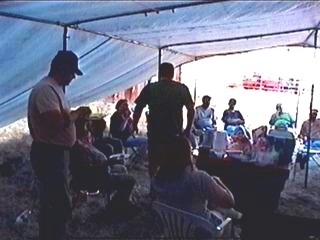
Local
witnesses gather at the base camp to meet the expedition
members and describe what they have observed in the area.
|
The first witness described a daylight sighting that had occurred
two years earlier. This male witness and a male friend had gone
to an Anasazi (ancient Indian people) ruins site in the mountains
for the afternoon, and were confronted at very close range by a sasquatch
in the vegetation, immediately adjacent to the trail.
After seeing the sasquatch, the two retreated to high ground to
wait for a safe moment to leave. After a couple of hours, they nervously
made their way back to their vehicle and left.
The host then described some incidents that took place on
his ranch, the location of the base camp. Several occurrences involved
very loud howls from the wooded canyon areas surrounding the ranch.
A male caretaker had described to the host one such occurrence while
staying at the ranch. On another occasion the host heard a similar
vocalization himself, one that could not be attributed to any known
species of wildlife or domestic livestock.
On a third occasion, while working together in the barn area, both
men heard intense loud screams emanating from the wooded area up
the canyon from the ranch. This incident was so unnerving that the
men left the ranch immediately. The caretaker refused to return
to the ranch after that incident.
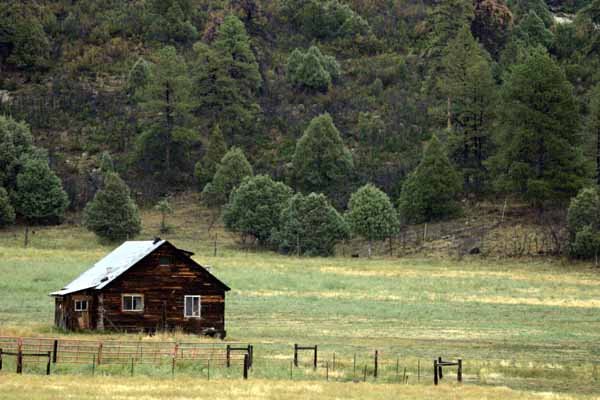
The
old ranch house described in some of the sighting stories.
|
The host also described a daytime sighting from the ranch house.
He observed a sasquatch about 100 yards away. It moved along the
tree line, and walked through a clearing about thirty yards wide.
He drove down to a place close to where the animal was seen, but
as he started to exit the truck to investigate, he had second thoughts
and departed.
A couple of months prior to the expedition, the third male witness
and his male friend, while at the same Anasazi site mentioned by
the first male witness, also had an encounter. Just prior to the
sighting, this witness reported hearing a loud "thump." Both were
then startled to see a reddish brown sasquatch crashing downhill
through the brush. They described smelling a very strong odor immediately
afterward.
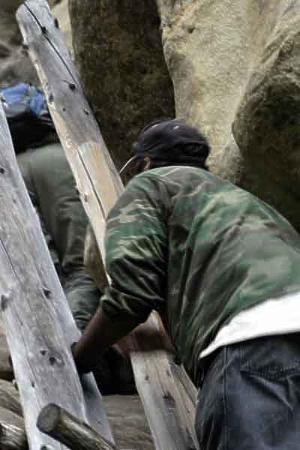
Mike
Se. (NM) climbs a log ladder made for accessing an Anasazi
cliff ruins site -- one of many in the region.
The various ruins sites we saw were not marked on any maps.
Only the most accessible ruins site was known to the property
owners.
The expedition group spotted several other Anasazi ruins
sites while penetrating these canyons in search of sasquatch
evidence.
|
A fourth male witness described a daylight sighting that occurred
while he and his dogs were herding cattle. The witness was on horseback
while his dogs were running among the cattle. Suddenly the dogs
ran under his horse. He looked up and saw a sasquatch about sixty
feet away. He described it as very tall -- taller than himself
while mounted on his horse.
The animal merely glanced at him over its shoulder and continued
to move away in a deliberate manner, as if preoccupied with something
other than the witness and his dogs.
A female witness next described a sighting she had while on her
way home from work at about 8:00 a.m. She saw a sasquatch standing
on a ridge overlooking her house. She ran inside to get everyone
to come out to see it, but when they came back outside, the animal
was gone.
A second female witness shared that when she and a female friend
were nine and seven years of age, respectively, they were with their
family on an outing.
The girls became bored and took a walk. They heard a tree being
vigorously shaken. They were afraid it might be a bear, but got
closer to see what was making the noise. They saw a very large sasquatch
staring up into an aspen tree, and shaking it hard. A smaller sasquatch
stood near the first, also staring up into the tree. Both animals
were described as grayish brown in color and having very long arms.
The girls had never heard any sasquatch-related stories before this
experience; when they tried to tell the adults, they were not taken
seriously.
A third female witness and her husband shared an experience they
had on the ranch. They had been coming out to the ranch every day
after work to tend a vegetable garden they had planted. One evening,
just at dark, they heard a series of menacing vocalizations from
the nearby ridge and wood line, the same general area where the
rancher and the caretaker had heard mysterious sounds on previous
occasions. The man and his wife were so shaken that they left immediately
and never returned to the garden again.
Thursday Night
: A Night Hike to the North of the Ranch
After hearing the stories of the local witnesses, the crowd was
shown how to use night-vision goggles. Participants and a few local
residents separated into small groups and headed to different locations
for night hikes. Some walked the wood line in the canyon near the
ranch. Others distributed fruit piles at bait sites. Others drove
to the Anasazi site identified by local witnesses.
Moonlight for this date was bright; the full moon occurring only
four days earlier. Skies were clear the first night.
The group at the Anasazi site noticed a very strong odor ("like
a cross between a skunk and an open sewer") at one point, on the
breeze coming down the canyon. The smell came and went quickly.
Two of the teams walking through a different canyon got spooked.
One group described hearing footsteps following them from inside
the tree line. The other group said small rocks were thrown at them
from the dark tree line. There were night vision goggles
among both teams, but nothing was seen through the trees and brush
inside the treeline. Both teams returned to the base camp shortly
after these incidents.
Friday Morning
: In the Finger Canyons -- Rocks Thrown, Tracks, Scats
On Friday morning, a large group was organized to spread out through
several connected "finger" canyons near where a sighting
had occurred in the recent past.
One team was sent to a high point to surveil the canyons from above,
as the other groups entered the canyons from below. The idea was to
push any large animals up and out of the canyons and into the view
of the team scoping these canyon rims from the higher mountain peak.
All the teams were continually in contact via walkie talkie, and
each team had at least one camcorder among them.
The three major canyons in the fingers area were designated A,
B and C. As the canyons were explored, a few more connecting canyons
were found and named Canyon "B Minor" and Canyons D and
E.

The tracks, scats, and sounds were noticed in "box canyons"
-- steep-walled, sandstone canyons. Box canyons have strategic
advantages for both ambushing large animals and evading intruders.
|
Within a few minutes of entering the network of canyons, one participant
in Canyon A reported being hit in the back by a rock. He was bringing
up the rear of his group.
He looked around to ascertain where the rock came from. He scanned
the tree lines and searched the dense brush nearby. Nothing was found
or seen. The radios allowed him to verify the positions of the other
groups.
The group continued into Canyon A, the largest canyon (and the
one where the sighting had occurred the year before). Two members
climbed the south ridge, and two others climbed the north ridge.
The local guide hiked the canyon bottom between them.
The guide came upon a bear and radioed that it ran up the south
slope. The people on the south ridge did not see it, but the group
later found a fresh set of bear tracks in a patch of loose soil
along a ridge.
|
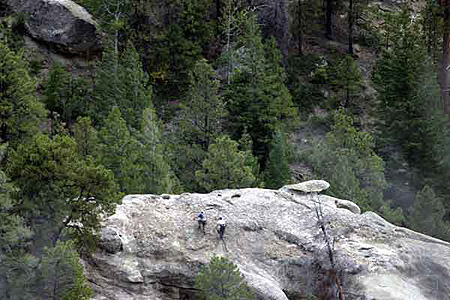
A group climbs the north ridge of "Canyon A" on
the second day of the trip.
|
No one observed a sasquatch in the finger canyons, but several
partial, or weathered tracks in the 17" to 18" range were found
and several scat piles were located which no one could identify.
|

The
bottom of "Canyon B" as seen from the rim of
the canyon wall. This is one of a few box canyons with both
a history of activity and several track and scat finds during
this expedition.
The thrust of this first expedition was to find places like
this for purposes of future study.
|
|
|
There were elk droppings in abundance in these canyons, and several
obvious bear scats were found, but there were also some very large
scats that were clearly different from the bear scats and elk droppings.
The bear scats contained partially chewed scrub oak acorns and
bits of twigs and leaves. The unidentified scats were dramatically
larger than the bear scats, and were composed exclusively of what appeared to be finely chewed acorns
with no bits of twigs, leaves or other material mixed in. The contents were so finely
chewed that the scats had the consistency and appearance of peanut
butter.
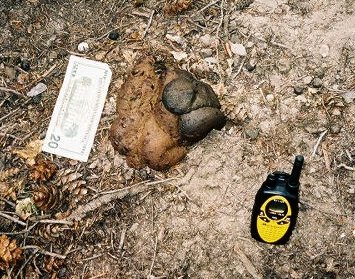
A
scat of finely chewed acorns, with a fresher scat on top.
The dark color of the fresher scat may indicate that it included animal protein.
|
A local guide later said the strange, large scats we found at various
points in these canyons had been observed,
but were simply never identified. Many found this day were
quite fresh. A few of them had a similar size, shape, and consistency, but
contained different material. They were dark and green, possibly indicating
the presence of digested animal protein.
Scat piles were collected by at least two participants.
|
|
During the last few hours of the canyon exploration, dark clouds
built up, followed by thunder, lightning and rain, in classic southwest
fashion. Everyone returned to base camp.
Friday Afternoon : At the Anasazi Site -- Two Class A Sightings
The rain let up a little in the afternoon. A group of participants
then drove to an area where some previous incidents had occurred.
After looking around for a while, the group decided to leave when
the rain started up again.
While returning to the vehicles, one participant, Chris B. (WA),
noticed a very strong odor. He asked his partner, Tracy H. (WA),
if she smelled it too. She did, and then she started walking in
the direction the smell seemed to be drifting from. Chris went immediately
up the dirt road to tell some of the other people about the smell.
As Tracy got about twenty feet off the road, she looked up and
saw, among the brush, a very large, dark hand and forearm. She began
calling out to the other people, at medium volume, saying that something
was in front of her in the brush. She kept her eyes on the arm,
then could see more of the large dark figure, partially standing
behind a tree.
At that point she yelled out to bring other people to her location.
That's when the animal turned and ran. Participant Kevin J. (WA)
ran over to Tracy's position, then ran past her to follow the animal.
After running several yards, fighting his way through the brush,
he stopped and heard branches snapping up the hill. He followed
the sounds up the slope.
Within a minute, he spotted movement ahead of him. He stopped
and observed a sasquatch standing behind a tree approximately thirty yards away.
Its shoulders could be seen on either side of the large trunk. The
animal reached up and snapped a branch off the tree, leaned out, and
made eye contact with Kevin, It turned, and continued
moving up the hill quickly.
Kevin ran to the base of the tree and continued in the direction
of the fleeing animal. As Kevin approached the saddle of the hill,
he saw the sasquatch standing in clear view on a rock outcrop around
100 yards away. It made eye contact again, turned, disappeared
behind the rocks, and was not seen again.
After spending a couple of minutes catching his breath and watching
for movement, Kevin went back down the hill. He immediately told
the others what happened. By that point the rain started pouring
and people were scrambling to get to their vehicles and drive out
of the area. The muddy, rutted road was quickly becoming impassable.
The group returned to base camp and told the others what had happened.
A plan was devised for the next day for a few people to return
to that area, set out a pile of apples, and leave a camcorder
running nearby.
|
|
Saturday
: Mostly Rained Out, Sounds Heard in Finger Canyons
It rained hard throughout Friday night. The rainfall did not let
up until Saturday afternoon.
The host warned people not to drive along the muddy roads
until they had a few hours to dry out. When the roads were solid
enough to drive on again, in the late afternoon, one group of participants
returned to the finger canyons, and another group returned to the
area of the daylight sightings.
In the Finger Canyons, the tracks observed on the previous day
had washed away, but some vocalizations were heard by a handful
of people. A few people climbed up a high rock face in order to
keep watch on a spring in the canyon below. Soon lightning and rain
returned, driving them from their perch, and forcing them to return
to base camp before the roads again become impassable.

Most people think of New Mexico as a hot, dry state. Most
of the state is hot and dry most of the time, however, the
higher elevations receive rain or snow almost year round.
Warm, moist air from the Gulf of Mexico causes brief rain
showers in the mountain ranges nearly every day in the summer
and fall.
|
|
|
The group that returned to the location of the previous daylight
sighting was not able to get there until just before dark. They
realized their bait and camcorder plan would not work in the dark,
so it was postponed until the next day.
On Saturday night the weather looked unstable so everyone stayed
around base camp and most used the opportunity to catch up on sleep.
A few stayed up late, talking around the campfire. Eventually, some
returned to their tents while others slept in their chairs near
the fire.
Sunday : Activity Closer to Base Camp
Early Sunday morning, at 4:45 a.m., several participants heard two
very loud, very long, yell/roar type vocalizations that seemed to
come from the woods near the base camp. Others were awakened by
the sounds. The vocalizations occurred about two minutes apart,
and emanated from the same general area where the host and
his caretaker had heard the vocalizations before.
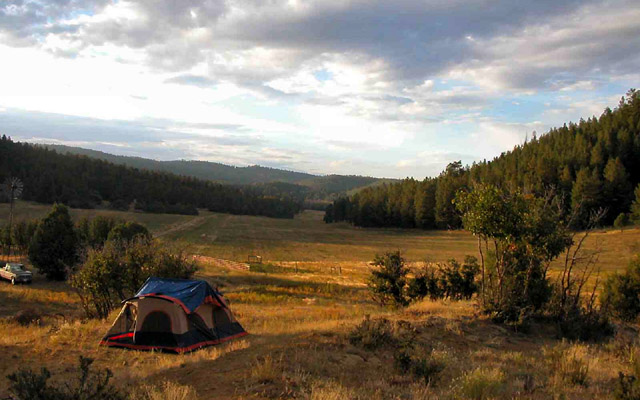
Morning
at the ranch. The rancher plants alfalfa in this field.
The field extends for a mile or so down this valley. He
allows the deer and elk to graze on the alfalfa when he
doesn't harvest it.
The first few participants to arrive at the ranch at night
counted 70-80 deer and 30-40 elk in this alfalfa field.
|
|
|
On Sunday morning the early risers made breakfast and coffee then
started preparing for their departure. Steve C. mentioned hearing
wood knocks from the nearby hillside, at some point in the early
morning hours.
As other people began to wake up, more of them mentioned hearing
loud wood knocks as well, from a source that seemed to be moving
through the tree line.
The team that wanted to return to the Anasazi site, for a camcorder-and-bait
setup, got prepared and headed out. They set out a pile of apples
at the spot where the first daylight sighting happened on Friday.
An hour later they returned to retrieve the camcorder. The bait wasn't
touched, so they decided to focus elsewhere for the rest of the
day.
Another team headed in the same direction, toward the primary Anasazi
ruins site, to see the terrain beyond the site, deeper into the
canyons.
Lots of elk dung and tracks were found along the roads and game
trails near the Anasazi site. No sasquatch tracks were found, but
the entire area can be traversed without leaving tracks if one simply
stays on the sandstone rock.
|
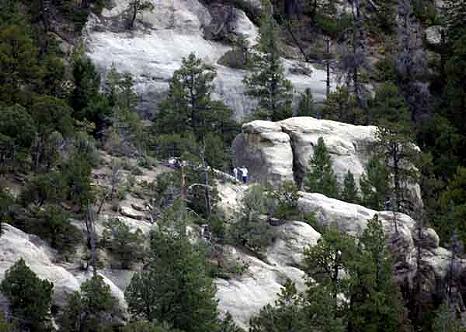
Participants exploring one of several remote Anasazi canyons
in Northern New Mexico.
Smooth rock terrain is ideal for evading intruders, as the
Anasazi did for so long. No footprints are left behind --
a huge strategic advantage. A whole community could live
here invisibly.
There are thousands of places to hide that have a commanding
view of all approaches. These
canyons gave us the feeling of invulnerability. It would
have been attractive back then too.
|
|
|
The entire expedition group was deeply impressed by the strategic
advantages of the terrain. Mazes of canyons snake for miles on the
flanks of mountains, and conceal thousands of caves and overhangs
of various shapes and sizes. Elusive inhabitants would be able to
detect and evade intruders with ease in these canyons.
There is an abundance of edible plants and wildlife throughout
the area. A hunter-gatherer community could survive here easily
without having to venture far from their isolated pockets of terrain.
The Anasazi were there for thousands of years. They abandoned the
area nearly 1,000 years ago. It is believed they abandoned the whole
region during a period of devastating droughts, possibly tribal
conflicts, and possibly religious upheavals. No one knows for sure
why they left or where they went.
Technically, there has been a drought throughout New Mexico for
the past seven years; however, it is not very apparent at this high elevation.
The water hasn't stopped flowing from the mountain springs, and
the sky still dumps rain or hail every afternoon during the driest
times of year. The land still looks wet and green in the late summer.
There are thousands of scattered, washtub size holes on top of
the rock plateaus that catch a few inches of rain or hailstones
almost every day in the summer and fall.
The shape of the terrain is perfect for trapping and ambushing elk.
Rock formations provide views of grazing areas, and the very few
roads leading into the area.
On Sunday more Anasazi cliff ruins were seen further back in the
canyons, north of the primary Anasazi site. The host and other residents
of the area were surprised to hear of other cliff ruins being found.
The expedition members were equally surprised to hear that the locals
weren't aware of the other cliff ruins.
Some local residents explained that they never went beyond the first
cliff ruins site because their grandparents had always told them
this area still belongs to the Anasazi, and is inhabited
by their spirits. The locals allowed expedition members to explore
these canyons, provided that we didn't touch or remove any artifacts,
but they flatly refused to come along. They became visibly uncomfortable
when approaching the unmarked boundaries beyond which they would
not venture.
After everyone returned to the base camp, the guides were very curious
to know what we saw and experienced in these areas.

Paul
M. (Net. Eng. from Buffalo, NY), Eric B. (Contractor from
Las Vegas, NV), and John C. (airline pilot from Seattle,
WA) preparing to hike up a slope near base camp to look
around up where sounds were heard the night before.
The tent in the background is the one that was visited by
the figure on Monday night.
|
|
|
Sunday was the last official day of the expedition. By mid-day
Sunday, most of the participants were packing for the trip home.
A few people wanted to stay a few more days. The ones who wanted to
stay longer headed to the nearest town to buy food, wash clothes,
and take showers.
On Sunday evening, the remaining people discussed where they wanted
to go for the evening. They discussed the sounds heard near base
camp the night before. Many agreed that base camp was the best place
to be.
One team decided to drive around in the dark with the headlights
off. The driver wore nightvision googles. The passenger had a high
end night-vision camcorder. The passenger shot video through the
windshield until his arms grew weary of holding up the heavy system.
He told the driver to let him know if he saw something with the
goggles, while he rested the camera against the dashboard.
At one point the vehicle drove over a hill and seconds later the
driver yelled that he saw something big running away through the
brush. By the time the camera was recording and pointed in the right
direction, the animal was gone. The driver described an upright,
dark shape moving very quickly. He said it was either the dark neck
of a running bull elk, or a running sasquatch.
It was useless to pursue the fleeing animal in the dark through
the brush. They decided to continue driving the roads while it was
still dark, and return to the location in daylight to look for
tracks. They drove until sunrise, but nothing further was seen or heard.
|
|
Monday : Covering
More Ground
Most people had been awake for most of Sunday night so they slept
in Monday morning. Some got up and hiked around in the surrounding
woods. Others needed to take it easy, after exerting themselves
for several days.

Chris
B. (WA) dozes at the campfire after an all-night vigil.
|
The team that drove around with their lights off the night before
went back to look for tracks where the possible sighting had occurred
the night before. They could not agree on the exact point along
the road where the fleeing animal was observed. Both areas were
checked.
The driver found large fresh elk tracks along a path where he thought
the animal fled. The elk tracks made him lean toward elk as
the explanation for what he saw.
No easily notable sasaquatch tracks were found along the road. Grass
and leaf litter blanketed the ground everywhere else, and the dirt
on the roads had been mostly compacted by vehicles. Tracks could not
be observed except where animals stepped onto soft parts of the roads
or animal trails. Less than 1% of the ground surface could
show clear tracks.
The road incident taught the driving team a few important lessons:
1) Don't assume you can easily find your way back to a spot along
a road where something happened the night before. When something
happens on a road at night, be ready to toss out some kind of simple
marker that you can easily spot when driving the road the next day.
2) The only reliable way to get video footage of these skittish
animals at night is to wear nightvision goggles that can record
to videotape. As on the previous expedition, if everything that
was observed through the nightvision goggles had been recorded onto
videotape, we would have had at least a few interesting pieces of
footage to examine.
|
|
After eating lunch in a nearby town, the group made plans for a
late afternoon exploration of a different set of canyons.
Aerial photos showed a set of canyons near the Fingers area with
the same kind of terrain. This other set of canyons also had a larger
spring than the Fingers.
Three people headed up into this canyon as darkness fell, but it
soon became treacherous for those who were not wearing nightvision
goggles.
When the three people returned to base camp, the group at the campfire
informed them that among other things, at least two small rocks were
thrown in their direction. One hit the roof of the ranch house.
The other landed near the campfire.
When the rock landed near the campfire, Kevin looked around with
nightvision goggles in the direction the rock seemed to come from,
the direction of the two tents in the field. He didn't see
any movement, or any unfamiliar objects.
In the time frame when the rocks were thrown, James F. (CA) was
standing near his vehicle repacking his gear. His vehicle was parked
about 200 feet from the two tents in the field. As he was repacking
his things he would occasionally pick up his nightvision goggles
and scan the area before setting them down to continue packing with
both hands.
At one point James looked across the field and noticed a figure
standing next to Kevin's tent. James assumed it was Kevin and didn't
pay much attention to it. The figure appeared to be leaning over
the tent and gently wiping the sides of the tent.
On a second pass with the goggles, James noticed the figure again.
This time it was beside the other tent, and was crouching down beside
it. James again assumed it was Kevin retrieving something from the
other tent.
A few moments later James saw Kevin sitting at the campfire and
asked him why he had been wiping condensation off the outside of
his tent. Kevin said he hadn't been to his tent all night. Kevin
checked with all of the remaining people, and no one had been near either
of the two tents for several hours.
The rock throwing happened around the time James noticed the figure
near the tents.
A few went to look for tracks around the tents, however the ground around
the tents by this point on the trip, was a well trodden blanket
of flattened alfalfa plants. There would be no footprints of anything.
A team decided to do one last stakeout in the field, near where
the most deer tend to congregate. Kevin, Tracy and Chris moved their
vehicle approximately a half mile from the campfire, to sit, watch, and
listen in the darkness.
Tracy periodically made loud screams imitating sasquatch screams.
Coyotes and owls responded to some of her screams.
At about 4:30 a.m. she walked over to the treeline and made another
whooping scream. This time, she got a response coming from inside
the nearby treeline. It closely mimicked her scream. She was certain
that it was not an owl. She said it sounded more like a person trying
to imitate her scream.
Tracy got back in the car and told the others. They endeavored to
stay awake until sunrise but heard nothing further.
As sunrise came the last few people began to depart from the ranch.
The last person left the ranch at noon.
The rancher-host thanked the departing people for coming. He said
he wanted to plan for another expedition next summer at the same
time of year.
A primary goal of this first, brief, excursion was to identify specific
sites. Follow-up expeditions can
springboard from the groundwork laid this year.
A variety of experiments and realistic objectives can be
tailored to suit these locations.
The rancher said he does not want another incursion into the area
until next year. He said he should "give the land a rest." We cannot
help but agree.
End of Report
The Trouble
with Footprint Photos
At this time, there are no track photos in this report.
The report should not contain any unclear photos. The track photos
we've seen so far from this trip do not clearly display a whole,
fresh track.
Sasquatch tracks can be impossible to preserve in two dimensional
photographs. They are three-dimensional by nature, most often
shallow pressure patterns in uneven soil. Their subtle indentations
seem to disappear in photos.
A good analogy is a satellite photo of a mountain range. A satellite
photo does not show depth, so mountainous terrain does not appear
to be elevated into the sky.
Flying around the mountain range in a small aircraft allows one
to "see" the range that was not visible in the satellite
photo.
An experienced tracker can identify tracks and track sign to anyone
who is there to examine them in three dimensions. There are usually
other footprints or sign nearby for comparison. The other impressions
and track sign help build the picture of what passed by, and the
size and shape of its feet.
Observers who would, on scene, agree that there are large footprints
along a trackway, would likely dismiss that suggestion if they only
saw photographs of the tracks.
|
 Copyright
© 2004 BFRO.net Copyright
© 2004 BFRO.net |
 |
|